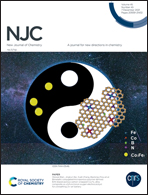A NaX zeolite framework containing magnetic MgFe2O4/CdO nanoparticles: synthesis, characterization and catalytic performance in the decontamination of 2-chloroethyl phenyl sulfide (2-CEPS) as a model of sulfur mustard agent†
Abstract
The present study highlights the successful fabrication of a zeolite NaX/MgFe2O4/CdO magnetically separable nanocomposite catalyst via an ultrasonic-assisted hydrothermal strategy for the decontamination of sulfur mustard agent simulant 2-chloroethyl phenyl sulfide (2-CEPS) for the first time. The as-fabricated nanocomposite was fully characterized using FESEM, TEM, EDAX, FTIR spectroscopy, XRD, AFM, VSM, N2-BET, and ICP-AES analyses. The decontamination process of 2-CEPS was monitored via GC-FID analysis. Furthermore, the effects of different analytical parameters such as contact time, catalyst type, catalyst amount and solvent type on the decontamination efficiency of 2-CEPS were precisely investigated. By using 50 mg of NaX/MgFe2O4/CdO catalyst in the presence of an n-heptane non-polar solvent, a decontamination efficiency of 100% was achieved after a contact time of 120 min. The decontamination process rate was verified by a first-order kinetic model. The obtained outcomes demonstrated that the apparent rate constant (kapp) and half-life time (t1/2) were 0.219 min−1 and 31.64 min, respectively. Lastly, the presence of hydrolysis and elimination products, namely 2-hydroxy ethyl phenyl sulfide (2-HEPS) and phenyl vinyl sulfide (PVS), from the effective degradation of 2-CEPS over the NaX/MgFe2O4/CdO catalyst was confirmed, and GC-MS analysis was performed to identify the degradation products of this agent simulant. This illustrates that the NaX/MgFe2O4/CdO catalyst could potentially be utilized for the removal of hazardous chemical warfare agents.



 Please wait while we load your content...
Please wait while we load your content...